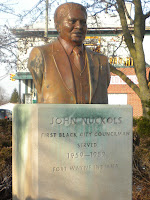
“Who Put that There: Outdoor Sculptures of Fort Wayne” is fun to look at—but it’s even more fun to actually visit the sculptures pictured in the book’s pages.
My son was visiting from NYC for Christmas and, as you well know, many of those who had left the city this year for the holiday had a challenge in returning at their appointed times. He was no exception so we had a few extra days together. Being with Mom and Dad for a week—when you’re 25 and single—doesn’t exactly make time fly so we set out one afternoon to do something besides watch television and eat.
Surprisingly enough, Chris, who has never really been “into history” but who loves art, got into the spirit as we drove around central
Our first stop was at the corner of Harmar and
According to the
From Nuckols we drove over to the Gas House to take a shot of the statue of Charles Louis Centlivre.
Centlivre was a Frenchman who moved to
The statue was a tribute from his employees, who had the creation installed on top of the Old Crown Brewery after their employer’s retirement.
IAS files indicate the sculpture was blown off the roof of the brewery by high winds in March 1964 and moved by Hall’s Restaurants in 1974 to its current location on the corner of Spy Run and Superior Streets.
Exiting the Gas House parking lot, we drove under the railroad tracks into the parking area behind the
Wayne
It was a really cold day so we did not park the car to take a close look at this sculpture. But on a warmer day it’s well worth your time to walk through the square and take a closer look.

From
Lawton
One of the many mysteries in Fort Wayne is why Lawton is in Lakeside Park, and not Lawton Park.
We then ventured to
The Civil War Monument is the oldest public sculpture in
Lincoln
As we drove home, we went a little out of our way down to one of the

Heading out Washington we noted the statues of David Foster and Perry Randall where the street swoops around to become Jefferson. This is no place to slow down for a drive-by sighting but you can pull into Swinney Park to take a closer look at the statue of Foster. Foster is the founder of the Fort Wayne parks system. The inscription on his statue speaks to the importance of remembering and honoring those who shaped this city:
“He will live forever, not because of his military record, not by reason of his business career but by the laughter of the children, the strength of the youth, the joy of the middle-aged who shall live and love and prosper and know real happiness in the Greater Fort Wayne of Tomorrow, which is his dream come true.”
“Who Put That There” contains far more statues and sculptures than we featured here. But as you can see, you can map out a wonderful drive (or two) around our city to take a look at our history and perhaps spur yourself and your children to learn more about the people who made Fort Wayne what it is today.
You can also find more information about these and other historical figures at the Allen County Public Library, in books at the History Center, and on the internet. And watch this blog for more stories of Fort Wayne.



Great article. I've put a hold on a copy of this library book, so will have to check it out. My great-great-granduncle Anthony Kelker gave the October 10, 1894 speech at the Civil War Monument, unfortunately they spelled his name Keller. Anthony and brother Samuel Kelker helped promote a lot of the early military monuments, and Anthony was the 1st park commissioner according to newspapers, but not credited by the park department history. I started to write their history, maybe this book will help me finish it. http://freepages.genealogy.rootsweb.ancestry.com/~sfollis/service/officials.html#kelker
ReplyDelete